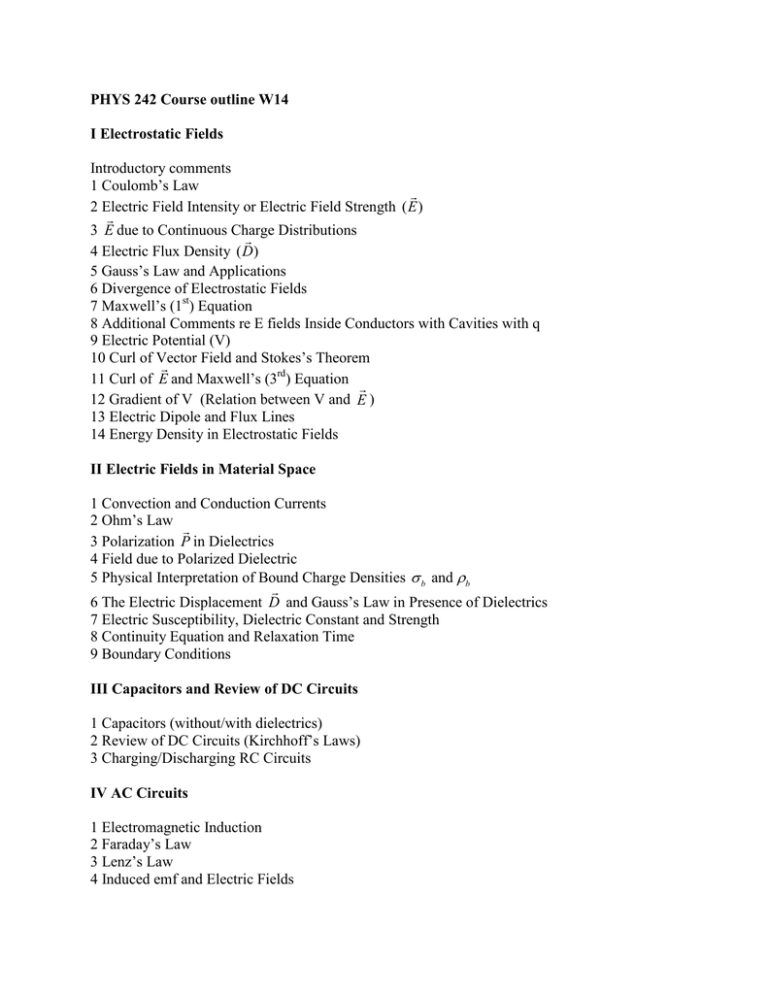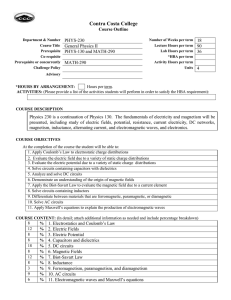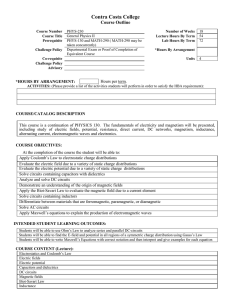PHYS 242 Course outline W14 I Electrostatic Fields Introductory
advertisement

PHYS 242 Course outline W14 I Electrostatic Fields Introductory comments 1 Coulomb’s Law 2 Electric Field Intensity or Electric Field Strength ( E ) 3 E due to Continuous Charge Distributions 4 Electric Flux Density ( D) 5 Gauss’s Law and Applications 6 Divergence of Electrostatic Fields 7 Maxwell’s (1st) Equation 8 Additional Comments re E fields Inside Conductors with Cavities with q 9 Electric Potential (V) 10 Curl of Vector Field and Stokes’s Theorem 11 Curl of E and Maxwell’s (3rd) Equation 12 Gradient of V (Relation between V and E ) 13 Electric Dipole and Flux Lines 14 Energy Density in Electrostatic Fields II Electric Fields in Material Space 1 Convection and Conduction Currents 2 Ohm’s Law 3 Polarization P in Dielectrics 4 Field due to Polarized Dielectric 5 Physical Interpretation of Bound Charge Densities σ b and ρb 6 The Electric Displacement D and Gauss’s Law in Presence of Dielectrics 7 Electric Susceptibility, Dielectric Constant and Strength 8 Continuity Equation and Relaxation Time 9 Boundary Conditions III Capacitors and Review of DC Circuits 1 Capacitors (without/with dielectrics) 2 Review of DC Circuits (Kirchhoff’s Laws) 3 Charging/Discharging RC Circuits IV AC Circuits 1 Electromagnetic Induction 2 Faraday’s Law 3 Lenz’s Law 4 Induced emf and Electric Fields 5 Inductance 6 LR Circuits (DC charging/discharging) 7 Energy in Magnetic Field 8 Introduction to Alternating Current (AC) circuits - the Phasor, Root-Mean-Square Values, Power 9 Phasor Approach Using Complex Notation - Kirchhoff’s laws, Low Pass and High Pass Filters Note re choice of textbook for the W14 offering of PHYS 242 The textbook chosen for this course is “Introduction to Electrodynamics” (4th edition) by David Griffiths. In addition, the availability of a good 1st year physics text (e.g. “Physics For Scientists and Engineers” (7th edition) by Serway and Jewett) is required for the magnetic induction and AC circuits part of this course. The electricity parts of this course have been taken from both the text by Griffiths and the book, “Elements of Electromagnetics” (5th edition), by M.N.O. Sadiku. The order of presentation of the material, making up this component of the course, largely follows the book by Sadiku. For convenience the outlines of the pertinent chapters of the books by Griffith, Sadiku and Serway/Jewett are given below. ================================== From “Introduction to Electrodynamics” (4th edition) by Griffiths: 2 ELECTROSTATICS 2.1 THE ELECTRIC FIELD 2.1.1 Introduction 2.1.2 Coulomb's Law 2.1.3 The Electric Field 2.1.4 Continuous Charge Distributions 2.2 DIVERGENCE AND CURL OF ELECTROSTATIC FIELDS 2.2.1 Field Lines, Flux, and Gauss’s Law 2.2.2 The Divergence of E 2.2.3 Applications of Gauss’s Law 2.2.4 The Curl of E 2.3 ELECTRIC POTENTIAL 2.3.1 Introduction to Potential 2.3.2 Comments on Potential 2.3.3 Poisson’s Equation and Laplace’s Equation 2.3.4 The Potential of a Localized Charge Distribution 2.3.5 Boundary Conditions 2.4 WORK AND ENERGY IN ELECTROSTATICS 2.4.1 The Work it Takes to Move a Charge 2.4.2 The Energy of a Point Charge Distribution 2.4.3 The Energy of a Continuous Charge Distribution 2.4.4 Comments on Electrostatic Energy 2.5 CONDUCTORS 2.5.1 Basic Properties 2.5.2 Induced Charges 2.5.3 Surface Charge and the Force on a Conductor 2.5.4 Capacitors 4 ELECTRIC FIELDS IN MATTER 4.1 POLARIZATION 4.1.1 Dielectrics 4.1.2 Induced Dipoles 4.1.3 Alignment of Polar Molecules 4.1.4 Polarization 4.2 THE FIELD OF A POLARIZED OBJECT 4.2.1 Bound Charges 4.2.2 Physical Interpretation of Bound Charges 4.2.3 The Field Inside a Dielectric 4.3 THE ELECTRIC DISPLACEMENT 4.3.1 Gauss’s Law in the Presence of Dielectrics 4.3.2 A Deceptive Parallel 4.3.3 Boundary Conditions 4.4 LINEAR DIELECTRICS 4.4.1 Susceptibility, Permittivity, Dielectric Constant 4.4.2 Boundary Value problem with Linear Dielectrics 4.4.3 Energy in Dielectric Systems 4.4.4 Forces on Dielectrics ============================================== From “Elements of Electromagnetics” (5th edition) by Sadiku: 4 ELECTROSTATIC FIELDS 4.1 Introduction 4.2 Coulomb’s Law and Field Intensity 4.3 Electric Fields Due to Continuous Charge Distributions 4.4 Electric Flux Density 4.5 Gauss's Law-Maxwell's Equation 4.6 Applications of Gauss's Law 4.7 Electric Potential 4.8 Relationship between E and V-Maxwell's Equation 4.9 An Electric Dipole and Flux Lines 4.10 Energy Density in Electrostatic Fields 4.11 Application Note-Electrostatic Discharge 5 ELECTRIC FIELDS IN MATERIAL SPACE 5.1 Introduction 5.2 Properties of Materials 5.3 Convection and Conduction Currents 5.4 Conductors 5.5 Polarization in Dielectrics 5.6 Dielectric Constant and Strength 5.7 Linear, Isotropic, and Homogeneous Dielectrics 5.8 Continuity Equation and Relaxation Time 5.9 Boundary Conditions 5.10 Application Note-High Dielectric constant Materials ============================================== From :Physics for Scientists and Engineers” (7th edition ) by Serway and Jewett: Chapter 31 Faraday’s Law 31.1 Faraday's Law of Induction 31.2 Motional emf 31.3 Lenz's Law 31.4 Induced emf and Electric Fields 31.5 Generators and Motors 31.6 Eddy Currents Chapter 32 Inductance 32.1 Self-Induction and Inductance 32.2 RL Circuits 32.3 Energy in a Magnetic Field 32.4 Mutual Inductance 32.5 Oscillations in an LC Circuit 32.6 The RLC Circuit Chapter 33 Alternating Current Circuits 33.1 AC Sources 33.2 Resistors in an AC Circuit 33.3 Inductors in an AC Circuit 33.4 Capacitors in an AC Circuit 33.5 33.6 33.7 33.8 33.9 The RLC Series Circuit Power in an AC Circuit Resonance in a Series RLC Circuit The Transformer and Power Transmission Rectifiers and Filters PHYS 242 2014W Session Course Content I Electrostatic Fields Instructor Office: Physics, room 366 Introductory comments 1 Coulomb’s Law 2 Electric Field Intensity or Email: peemoeller@uwaterloo.ca Electric Field Strength ( E ) Dr. Hartwig Peemoeller Office hours: W 12:30-1:30, F 4:30-5:30 Please include the text “phys242” in the subject of any emails. Textbook Texts: “Introduction to Electrodynamics” by Griffiths, 4 th edition and th “Physics for Scientists and Engineers 7 edition” by Serway and Jewett, or equivalent text (e.g., “Essential University Physics” by Wolfson “Fundamentals of Physics” by Halliday, Resnick and Walker th “University Physics 13 edition” by Young and Freedman) LEARN: https://learn.uwaterloo.ca UH Lectures Lectures will be held in MC 2034 Tuesdays and Thursdays from 8:30- 9:50 am. Lectures are an integral part of this course and attendance is required. 3 E due to Continuous Charge Distributions 4 Electric Flux Density ( D ) 5 Gauss’s Law and Applications 6 Divergence of Electrostatic Fields 7 Maxwell’s (1st) Equation 8 Additional Comments re E fields Inside Conductors with Cavities with q 9 Electric Potential (V) 10 Curl of Vector Field and Stokes’s Theorem 11 Curl of E and Maxwell’s (3rd) Equation 12 Gradient of V (Relation Course web site HU 8 Continuity Equation and Relaxation Time 9 Boundary Conditions between V and E ) 13 Electric Dipole and Flux Lines 14 Energy Density in Electrostatic Fields II Electric Fields in Material Space 1 Convection and Conduction Currents 2 Ohm’s Law Tutorials To be announced. 3 Polarization P in Dielectrics 4 Field due to Polarized Dielectric 5 Physical Interpretation of Bound Charge Densities σ b and ρb 6 The Electric Displacement D and Gauss’s Law in Presence of Dielectrics 7 Electric Susceptibility, Dielectric Constant and Strength III Capacitors and Review of DC Circuits 1 Capacitors (without/with dielectrics) 2 Review of DC Circuits (Kirchhoff’s Laws) 3 Charging/Discharging RC Circuits IV AC Circuits 1 Electromagnetic Induction 2 Faraday’s Law 3 Lenz’s Law 4 Induced emf and Electric Fields 5 Inductance 6 LR Circuits (DC charging/discharging) 7 Energy in Magnetic Field 8 Introduction to Alternating Current (AC) circuits - the Phasor, Root-Mean-Square Values, Power 9 Phasor Approach Using Complex Notation - Kirchhoff’s laws, Low Pass and High Pass Filters Assignments Final Exam Midterm Test There will be 6 to 8 assignments. Due dates will be indicated on the assignments. There will be a 150 minute exam to be scheduled by the registrar. The exam schedule will be placed on the UW web site by the registrar’s office. February 13, 6:30-8:00 pm in Physics room 313. In general, late submissions will not be accepted. Exceptions due to illness, or other reasons beyond the student’s control, will be considered on an individual basis. The drop-off box for assignments is just outside (on right hand side) of physics room 211A (opposite to room 204)). Assignments will be posted on LEARN at least one week before the due date. Solutions for all assignments will be posted on LEARN. Please see the note below regarding the return of assignments. Pink tie calculators only are permitted for purposes of writing the exam. Please see the following web site for details http://math.uwaterloo.ca/math/curre nt-undergraduates/regulations-andprocedures/calculator-regulation Pink tie calculators only are permitted for purposes of writing the midterm test. Please see the following web site for details http://math.uwaterloo.ca/math/currentundergraduates/regulations-andprocedures/calculator-regulation Course mark Assignments 20% Midterm Test 20% Final Exam 60% Note re assignment returns: The assignments will be marked and returned to you (normally in a week) by being placed inside cardboard boxes outside room 366 in physics (see the Note below). NOTE: Marked assignments will be left in boxes outside of room physics 366 for no longer than two weeks. Students who prefer an alternative return method must so advise the instructor (HP) by email by January 20, 2014 and staple an appropriately sized stamped self-addressed envelope to each assignment submitted so that it may be returned by mail. Unclaimed assignments: Unclaimed assignments will be retained until one month after term grades become official on Quest. After that time, they will be destroyed in compliance with UW’s confidential shredding procedures. Calendar course description: Course ID: 013643 PHYS 242 LEC,TUT 0.50 Electricity and Magnetism 1 Coulomb's law, electric fields, Gauss' law, potential, capacitance, properties of dielectrics, DC circuits, AC circuits. [Note: Students with PHYS 122 prior to Winter 2012 need to include PHYS 191 as a prerequisite. Offered: W,S] Prereq: One of PHYS 112, 122 (taken Fall 2011 or later), PHYS 191; One of MATH 128, 138, 148; (MATH 227 or Coreq: AMATH 231). Coreq: PHYS 242L for science students except Mathematical Physics plan. Antireq: PHYS 222, 223, 241, 252 Important Dates: See the University of Waterloo website for important dates connected with your program. For students with disabilities: AccessAbility Services, located in Needles Hall, Room 1132, collaborates with all academic departments to arrange appropriate accommodations for students with disabilities without compromising the academic integrity of the curriculum. If you require academic accommodations to lessen the impact of your disability, please register with AccessAbility Services at the beginning of each academic term. Some Academic Regulations: 1) Academic integrity: In order to maintain a culture of academic integrity, members of the University of Waterloo community are expected to promote honesty, trust, fairness, respect and responsibility. Note on avoidance of academic offences: All students registered in the courses of the Faculty of Science are expected to know what constitutes academic integrity, to avoid committing academic offences, and to take responsibility for their actions. When the commission of an offence is established, disciplinary penalties will be imposed in accord with Policy #71 (Student Academic Discipline). For information on categories of offences and types of penalties, students are directed to consult Policy #71 (http://www.adm.uwaterloo.ca/infosec/Policies/policy71.htm). If you need help in learning what constitutes an academic offence; how to avoid offences such as plagiarism, cheating, and double submission; how to follow appropriate rules with respect to “group work” and collaboration; or if you need clarification of aspects of the discipline policy, ask your TA and/or your course instructor for guidance. Other resources regarding the discipline policy are your academic advisor and the Undergraduate Associate Dean.” Grievance: A student who believes that a decision affecting some aspect of his/her university life has been unfair or unreasonable may have grounds for initiating a grievance. Read Policy #70, Student Petitions and Grievances, Section 4. When in doubt contact the department’s administrative assistant who will provide further assistance. Discipline: Students are expected to know what constitutes academic integrity, to avoid committing academic offenses, and to take responsibility for their actions. Students who are unsure whether an action constitutes an offense, or who need help in learning how to avoid offenses (e.g., plagiarism, cheating) or about “rules” for group work/collaboration should seek guidance from the course professor, academic advisor, or the Associate Dean of Science for Undergraduate Studies. For information on categories of offenses and types of penalties, students should refer to Policy #71, Student Discipline. For information on typical penalties, students should check Guidelines for the Assessment of Penalties, www.adm.uwaterloo.ca/infosec/guidelines/penaltyguidelines.htm. Appeals: A decision or penalty imposed under Policy 33 (Ethical Behavior), Policy #70 (Student Petitions and Grievances) or Policy #71 (Student Discipline) may be appealed, if there is a ground. Students, who believe they have a ground for an appeal should refer to Policy #72 (Student Appeals). Waterloo's Office of Academic Integrity provides numerous resources on academic integrity for students, faculty and staff. 2) Travel and final exam period: “Student travel plans are not considered acceptable grounds for granting an alternative examination time.” (You may wish to start checking the registrar’s web site starting in the middle of February: http://www.registrar.uwaterloo.ca/exams/finalexams.html). HU UH 3) Make-up exams, tests, assignments: In general there will be no make-up exams, make-up tests or make-up assignments for PHYS 242. Exceptions due to illness, or other reasons beyond the student’s control, will be considered on an individual basis. 4) Verification of Illness form (VIF) or other compelling documentation. If a student is unable to complete course requirements (usually final exam, midterm test), then the student must inform the instructor (ideally, beforehand but within 48 hours of the exam) and present the appropriate documentation (i.e. a completed VIF or other compelling documentation) within five business days. Please be aware that only VIFs issued from our campus Health Services (https://uwaterloo.ca/health-services/) will be acceptable documentation when the service is available (https://uwaterloo.ca/health-services/student-medical-clinic/after-hours-clinics). A student who is sick on a weekend, during off‐hours, while out of town or receiving ongoing care from a family physician or specialist may have to provide valid and suitably informative VIF from other health service providers. Information should include 1) date of the physician assessment 2) dates of illness 3) level of incapacitation, and 4) whether the diagnosis was made by the physician or based on description by the student. This policy will also apply to non‐Science students taking Science courses.

